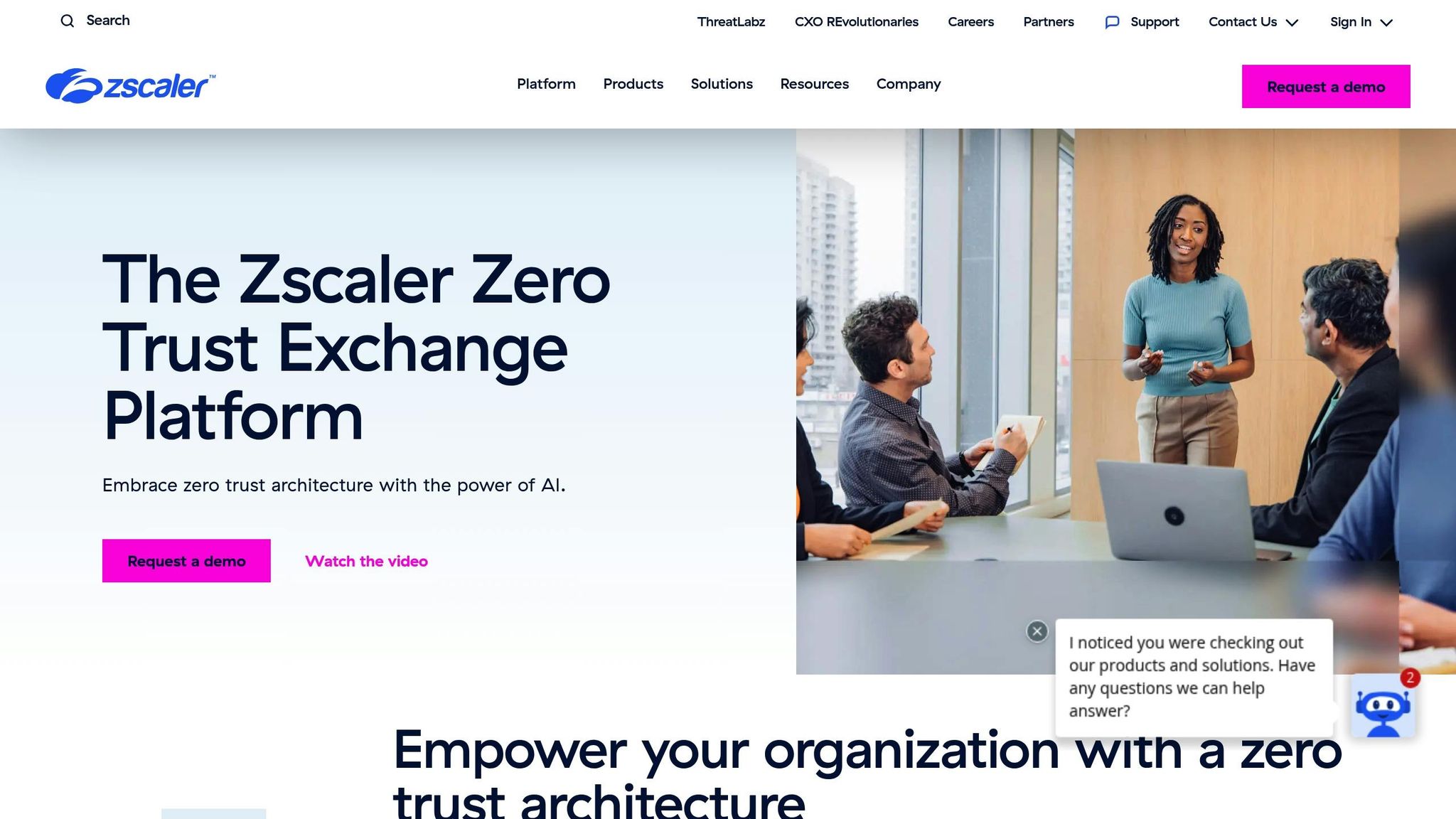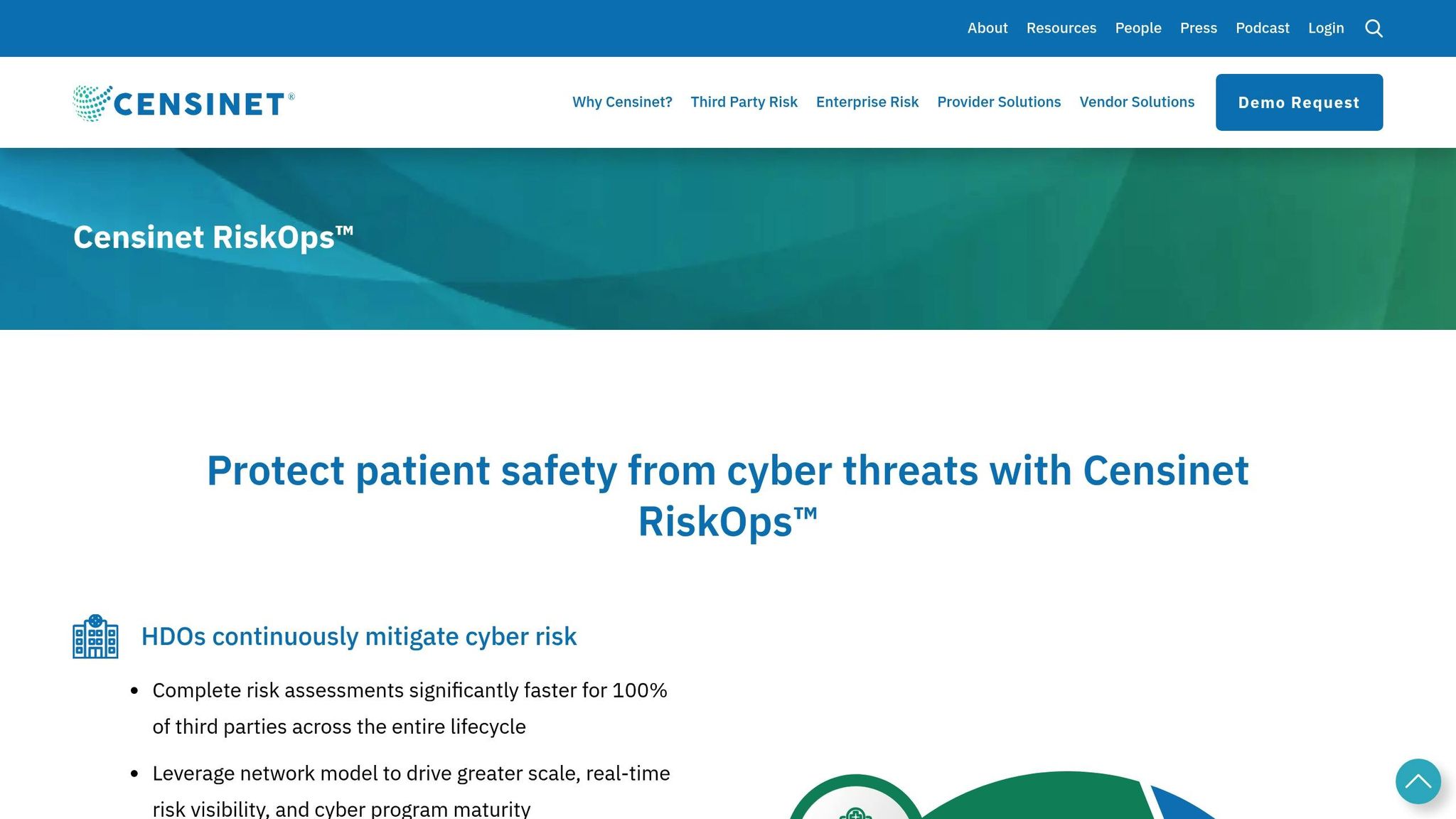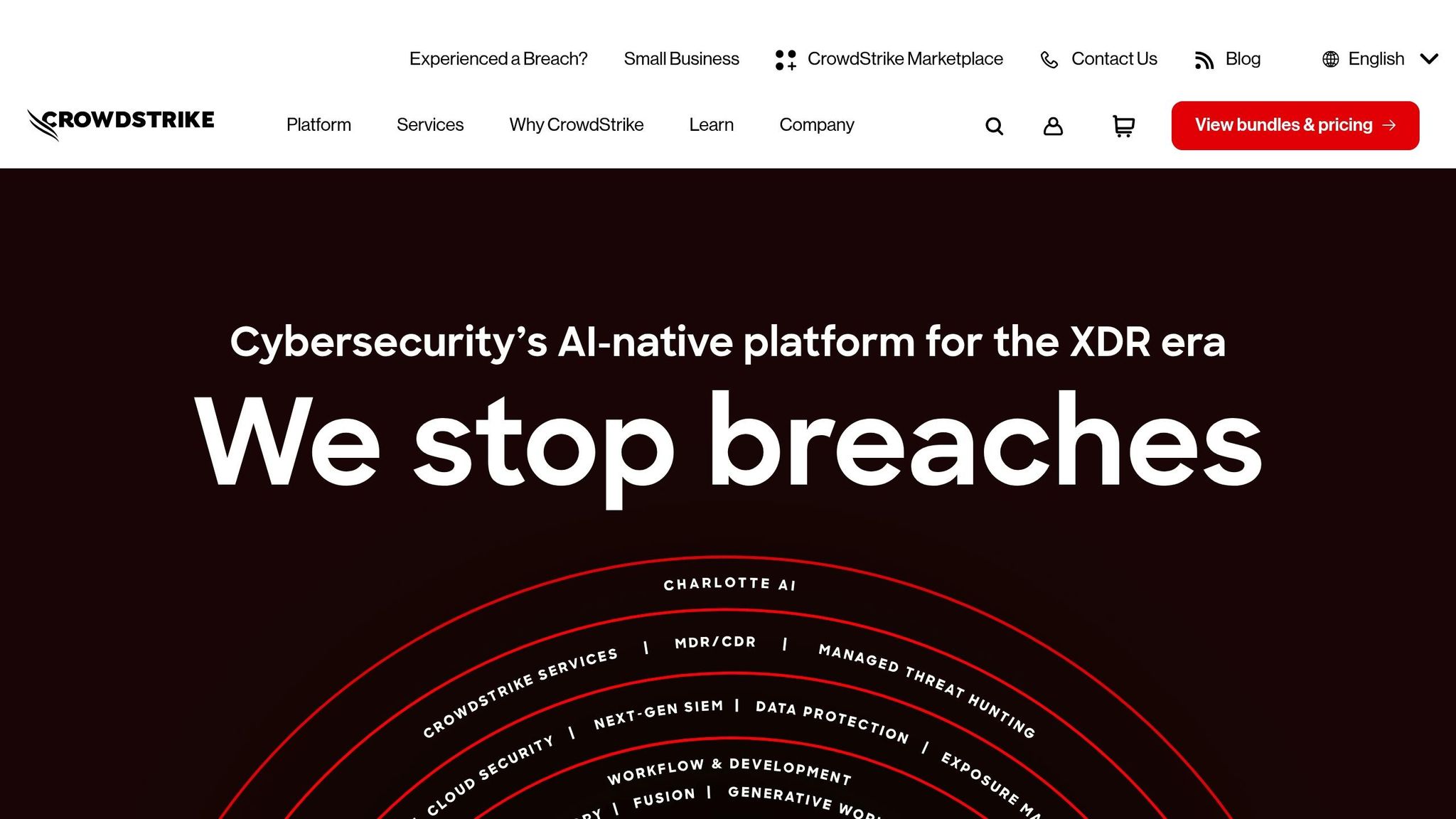2025 Healthcare Cybersecurity Tools Comparison
Post Summary
The top tools include Zscaler for cloud security, Censinet RiskOps™ for third-party risk management, CrowdStrike Falcon for endpoint protection, and ManageEngine DLP+ for data loss prevention.
Rising threats like AI-driven ransomware, IoMT vulnerabilities, and stricter compliance standards make robust cybersecurity essential to protect patient data and ensure operational continuity.
Zscaler offers AI-driven threat detection, IoMT security, and HIPAA compliance integration, making it ideal for cloud-based healthcare systems.
Censinet RiskOps™ focuses on third-party risk management with AI-powered assessments, real-time monitoring, and automated compliance tools tailored for healthcare.
CrowdStrike Falcon provides advanced endpoint protection, medical IoT security, and rapid threat neutralization with an average dwell time of under 1 hour.
Visit Censinet’s website or contact info@censinet.com for more information.
Healthcare organizations face rising threats in 2025, with data breaches costing $4.88 million per incident and 67% of providers reporting annual cybersecurity events. Key challenges include securing IoMT devices (43% vulnerability rate), AI-driven ransomware, and meeting updated HIPAA and NIST compliance standards. This guide compares four leading cybersecurity tools tailored for healthcare:
- Zscaler: Cloud-native platform with AI-driven threat detection, IoMT security, and HIPAA compliance integration.
- Censinet RiskOps™: Focuses on third-party risk management with AI-powered assessments and compliance automation.
- CrowdStrike Falcon: Endpoint protection with fast threat neutralization and advanced medical IoT security.
- ManageEngine DLP+: Affordable data loss prevention with machine learning for ePHI detection and HIPAA compliance.
Quick Comparison
| Feature Category | Zscaler | Censinet RiskOps™ | CrowdStrike Falcon | ManageEngine DLP+ |
|---|---|---|---|---|
| Primary Strength | Cloud Security | Third-Party Risk | Endpoint Protection | Data Loss Prevention |
| Threat Detection | AI-powered | Vendor analytics | AI-driven EDR | Content-aware detection |
| HIPAA Compliance | Automated | Comprehensive | Endpoint-focused | Pre-configured policies |
| Medical Device Security | Strong IoT | Vendor assessment | Limited coverage | Network segmentation |
| Cost-Effectiveness | High ROI | Not specified | 316% ROI | Low cost for small practices |
For small practices, ManageEngine DLP+ offers affordable compliance tools. Mid-size hospitals benefit from Zscaler’s scalable cloud security. Large health systems should prioritize CrowdStrike Falcon for advanced endpoint protection, while academic centers may prefer Censinet RiskOps™ for managing third-party risks.
Cyber 2025: Are You Prepared?
1. Zscaler Platform Features

The Zscaler Zero Trust Exchange platform has become a go-to solution for tackling cybersecurity challenges in healthcare. It processes over 200 billion transactions and identifies 7 billion security incidents daily [1]. With its cloud-native design, it eliminates the need for on-site hardware, making it ideal for distributed healthcare systems [6]. This makes it well-suited for addressing critical challenges like AI-driven threats and vulnerabilities in IoMT devices projected for 2025.
Here’s a closer look at its key healthcare-focused features:
Advanced Threat Protection
Zscaler uses AI to detect anomalies in network activity and user behavior [10]. This is especially effective against advanced threats like deepfake-based social engineering [3][5]. Its sandboxing technology isolates and studies suspicious files, while encrypted traffic is decrypted and inspected for hidden risks. For example, the platform successfully blocked a phishing attack that bypassed standard email filters [11].
Healthcare Compliance Integration
Zscaler aligns closely with HIPAA requirements, including continuous monitoring updates [2]. Its features are designed to ensure healthcare organizations meet compliance standards:
| Feature | Purpose |
|---|---|
| Encryption | Protects patient data during transit to meet HIPAA technical safeguards |
| Access Controls | Implements role-based access with contextual factors |
| Audit Logging | Tracks all transactions comprehensively |
| DLP Integration | Prevents unauthorized disclosure of patient health information (PHI) |
One hospital network using these features saw a 30% annual drop in HIPAA-related incidents [3].
IoMT Security and Integration
With IoMT devices showing a 43% vulnerability rate, Zscaler enhances security through device profiling and activity monitoring [10]. It integrates seamlessly with EHR systems like Epic and Cerner while also supporting older healthcare applications via browser-based isolation [12].
For managing third-party risks, Zscaler enforces strict vendor access policies and provides continuous oversight. Organizations using these tools reported a 40% decrease in security incidents tied to third-party vendors [5].
The platform’s scalability delivers measurable outcomes. For instance, a mid-sized healthcare provider reduced costs by 25% and achieved a 200% ROI within 18 months [4].
2. Censinet RiskOps™ Platform Features

Censinet RiskOps™ is designed for automated risk management tailored to healthcare environments. Unlike Zscaler, which focuses on network security, this platform offers real-time threat insights powered by AI-driven evaluations [1].
AI-Powered Risk Assessment
Censinet uses AI to continuously evaluate networks, generating dynamic risk scores. Its machine learning models predict vulnerabilities and update risk profiles automatically. This approach is especially effective in identifying ransomware patterns that leverage AI [1][13].
Healthcare-Specific Compliance Integration
Censinet RiskOps™ simplifies compliance for healthcare organizations by aligning with key frameworks:
| Compliance Framework | Key Features |
|---|---|
| HIPAA | Automated evidence collection, Real-time monitoring |
| HITRUST | Continuous validation of controls |
| NIST | Gap analysis automation |
| State Regulations | Dynamic updates to meet state-specific rules |
These tools help organizations cut down time spent on audit preparation, thanks to automated evidence gathering and customizable templates [8]. Its HITRUST certification ensures sensitive healthcare data is well-protected, addressing updated HIPAA monitoring standards [6].
Third-Party Risk Management
With 40% of healthcare vulnerabilities linked to supply chains [7], Censinet offers essential tools to safeguard these networks:
- AI-driven vendor risk assessments
- Real-time monitoring of vendor networks
- Visual mapping of supply chain dependencies
- Shared remediation tools to collaborate with vendors
By integrating external data sources, the platform delivers more thorough third-party risk evaluations [1][3].
Integration Capabilities
Censinet RiskOps™ seamlessly connects with healthcare IT systems through:
- APIs for linking with EHR platforms
- Integrations with SIEM tools and vulnerability scanners
- Customizable workflows for tailored processes
- Advanced encryption for secure data exchanges [13]
3. CrowdStrike Falcon Platform Features

CrowdStrike Falcon delivers a cloud-based cybersecurity solution tailored for healthcare, leveraging AI to provide robust protection. Recent performance metrics highlight its 99% detection rate in MITRE ATT&CK evaluations, with an impressive average dwell time of under 1 hour - far quicker than the industry norm of 56 days [6]. This speed is crucial for safeguarding clinical operations against evolving threats, including AI-driven attacks.
Advanced Threat Detection System
CrowdStrike pairs behavioral analysis with Zscaler's network monitoring to focus on endpoint activity in healthcare settings. Its threat detection system processes over 1 trillion events daily, using AI to identify risks through:
| Detection Component | Application in Healthcare |
|---|---|
| Behavioral Analysis | Tracks medical device usage and EHR access patterns |
| Indicator of Attack (IoA) Detection | Detects techniques targeting healthcare systems |
| Predictive Security | Anticipates vulnerabilities in clinical workflows |
| Automated Response | Neutralizes threats while maintaining patient care continuity |
Healthcare Data Protection
To secure electronic health records, CrowdStrike Falcon combines strong encryption with detailed access controls. Its cloud-based design allows for quick deployment without requiring system downtime [6].
Medical IoT Security
The platform enhances medical device security by automating device discovery, utilizing lightweight agents for low-power equipment, and establishing behavioral baselines for normal operations. This directly addresses the 43% vulnerability rate in medical devices mentioned earlier.
Integration Capabilities
CrowdStrike Falcon integrates smoothly with major healthcare systems, using APIs to enable streamlined connections. Its SIEM integration ensures centralized monitoring of security across healthcare IT environments [1].
Threat Hunting Services
Using its proprietary Threat Graph Technology, the platform analyzes event relationships within healthcare networks. This proactive strategy focuses on identifying risks specific to clinical environments and aligns with the NIST IoT framework requirements discussed earlier.
sbb-itb-535baee
4. ManageEngine DLP+ Platform Features
ManageEngine DLP+ is designed to safeguard sensitive healthcare data, whether it's stored or being transferred. Unlike other tools that focus on network or endpoint security, this platform uses machine learning to pinpoint critical patient information across networks, devices, and cloud applications, all while implementing context-based policies [1].
Healthcare-Specific Compliance Framework
The platform simplifies HIPAA and HITECH compliance with automated processes. Its machine learning capabilities identify ePHI (electronic protected health information) and generate audit-ready reports. This automation has been shown to reduce HIPAA-related incidents by 30% in similar implementations like Zscaler [3]. Additionally, automated reporting can cut audit prep time by 40%, aligning with HIPAA's updated continuous monitoring standards.
| Protection Layer | Healthcare Application |
|---|---|
| Data Discovery | Automatically identifies ePHI across systems |
| Access Control | Role-based permissions for clinical workflows |
| Encryption | Secures data during transit and storage |
| Monitoring | Tracks data movement in real-time |
Advanced Threat Prevention
The platform uses AI to detect unusual data access patterns, focusing on protecting EHR (Electronic Health Record) systems. This includes safeguarding telehealth sessions and remote patient monitoring, ensuring these critical areas remain secure [1].
Medical Device Integration
ManageEngine DLP+ addresses IoT-related risks by using network segmentation and lightweight monitoring agents to secure medical devices [1].
Cost-Effective Implementation
For $995 per year covering 50 endpoints [2], this platform offers protection at a fraction of the cost of a potential data breach. Automated policy management and seamless integration also help reduce administrative workload.
Performance Metrics
Trusted by 280,000 organizations worldwide, the platform's healthcare-specific deployments have earned a 4.4/5 satisfaction rating on Gartner. Users particularly appreciate its seamless integration with EHR systems [15].
ManageEngine DLP+ stands out for its ability to protect sensitive healthcare data while ensuring smooth operations, making it a strong choice for healthcare providers [1].
Tool Comparison Chart
Based on detailed analysis and implementation data from healthcare organizations, here's a breakdown of leading cybersecurity tools in 2025:
| Feature Category | Zscaler | Censinet RiskOps™ | CrowdStrike Falcon | ManageEngine DLP+ |
|---|---|---|---|---|
| Primary Strength | Cloud Security | Third-Party Risk | Endpoint Protection | Data Loss Prevention |
| Threat Detection | AI-powered real-time detection | Vendor risk analytics | AI-driven EDR | Content-aware detection |
| HIPAA Compliance | Automated monitoring & encryption | Comprehensive management | Endpoint monitoring & encryption | Pre-configured policies |
| Cost (Annual) | $ | $ | $ | $ |
| ROI (3-year avg) | 150% | Not specified | 316% [3] | 20-30% risk reduction [10] |
| Medical Device Security | Strong IoT protection | Vendor assessment only | Limited coverage | Network segmentation |
| AI/ML Integration | Advanced | Moderate | Advanced | Basic |
Performance Highlights and Cost-Effectiveness
CrowdStrike Falcon stands out with the highest ROI (316% over three years [3]) due to its ability to quickly neutralize threats. On the other hand, ManageEngine DLP+ helps organizations cut compliance costs by 40% thanks to its automated reporting features [10]. CrowdStrike users also experience 74% faster breach detection [9], while Zscaler proves especially effective for healthcare organizations moving to cloud-based systems, excelling in cloud security deployment.
Real-World Impact
Organizations using AI-powered tools have reported cutting ransomware response times by 50% and improving third-party risk visibility by 60% [5][9]. These tools also enable 40% faster compliance audits [5] and a 35% drop in IoMT-related incidents [7], directly addressing key challenges in healthcare cybersecurity for 2025.
Healthcare providers with extensive cloud operations may find Zscaler to be the best fit, while those prioritizing vendor risk management should consider Censinet RiskOps™.
Recommendations by Organization Type
Based on the earlier analysis, these 2025 recommendations pair organizational needs with the strengths of specific tools:
Small Healthcare Practices (1-10 Physicians)
ManageEngine DLP+ is a practical choice for small practices, offering:
- HIPAA-compliant templates
- Cloud-based deployment
- Low IT resource demands
Mid-Size Hospitals (100-500 Beds)
For hospitals allocating 3-4% of their IT budgets to cybersecurity [1], Zscaler Platform provides:
- Scalable cloud security setup
- Zero Trust Network Access integration
- Protection for both Zero Trust environments and IoMT devices
Large Health Systems (500+ Beds)
CrowdStrike Falcon Platform is ideal for systems dedicating 6-7% of their budgets to cybersecurity [1], delivering:
- AI-driven protection against advanced ransomware threats
- Comprehensive endpoint security
- Average threat neutralization within 1 hour
CrowdStrike's managed threat hunting is especially helpful for the 76% of large organizations using security services [2].
Academic Medical Centers
Censinet RiskOps™ is tailored for academic centers, cutting vendor-related incidents by 60% [5]. It focuses on healthcare-specific third-party risk assessments and supply chain mapping, addressing the 40% of vulnerabilities tied to healthcare supply chains [7] highlighted earlier.
| Organization Type | Recommended Solution |
|---|---|
| Small Practices | ManageEngine DLP+ |
| Mid-Size Hospitals | Zscaler Platform |
| Large Health Systems | CrowdStrike Falcon |
| Academic Medical Centers | Censinet RiskOps™ |
FAQs
Which DLP solution is best?
The best Data Loss Prevention (DLP) solution depends on your organization's needs. Here’s a comparison of some popular options:
| Solution | Key Strength | Ideal Scenario | Critical Factors |
|---|---|---|---|
| Microsoft Purview | Seamless Office 365 integration | Microsoft-centric environments | HIPAA automation • EHR compatibility |
| Google Cloud DLP | Cloud scanning & flexible pricing | Mid-size cloud-first orgs | Real-time response • Cloud scalability |
| Symantec DLP | Hybrid infrastructure protection | Large enterprise systems | Third-party integration • Advanced protection |
For Microsoft 365-focused organizations, Microsoft Purview stands out with:
- Built-in integration for Office applications and SharePoint
- AI-powered data classification to identify PHI (Protected Health Information) [1][8]
For cloud-first organizations, Google Cloud DLP excels by offering:
- Automated threat detection updates
- Real-time scanning across cloud storage and collaboration platforms [2]
For large healthcare enterprises, Symantec DLP (Broadcom) is a strong choice, delivering:
- Comprehensive compliance management (rated 4.5/5 on Gartner Peer Insights) [14]
- Advanced protection for hybrid infrastructures
- Integration with third-party risk assessment tools
These solutions address specific DLP needs while complementing the tools discussed earlier. AI-driven DLP systems are particularly effective, reducing false positives by up to 40% compared to traditional methods [3]. This is critical, considering healthcare's average breach detection time of 56 days [6] and the staggering $4.88M average cost of a breach [1].
Related posts
Key Points:
What are the top healthcare cybersecurity tools for 2025?
The top tools for healthcare cybersecurity in 2025 include:
- Zscaler: A cloud-native platform with AI-driven threat detection and IoMT security.
- Censinet RiskOps™: A healthcare-specific platform for third-party risk management and compliance automation.
- CrowdStrike Falcon: An endpoint protection solution with advanced medical IoT security.
- ManageEngine DLP+: A cost-effective data loss prevention tool with machine learning for ePHI detection.
Why is cybersecurity critical for healthcare in 2025?
Healthcare organizations face rising threats, including:
- AI-driven ransomware: Targeting patient data and critical systems.
- IoMT vulnerabilities: 43% of medical devices are at risk.
- Compliance challenges: Meeting updated HIPAA and NIST standards.
Robust cybersecurity protects patient data, ensures compliance, and reduces breach costs, which average $4.88 million per incident.
How does Zscaler enhance healthcare cybersecurity?
Zscaler offers:
- AI-Powered Threat Detection: Identifies anomalies in network activity.
- IoMT Security: Profiles and monitors medical devices for vulnerabilities.
- HIPAA Compliance Integration: Provides encryption, access controls, and audit logging.
- Scalability: Ideal for cloud-based healthcare systems, reducing costs by 25% and achieving 200% ROI within 18 months.
What makes Censinet RiskOps™ unique?
Censinet RiskOps™ focuses on:
- Third-Party Risk Management: AI-driven vendor assessments and real-time monitoring.
- Compliance Automation: Aligns with HIPAA, HITRUST, and NIST frameworks.
- Integration Capabilities: Connects with EHR platforms, SIEM tools, and vulnerability scanners.
- Healthcare-Specific Features: Visual mapping of supply chain dependencies and shared remediation tools.
How does CrowdStrike Falcon protect healthcare organizations?
CrowdStrike Falcon provides:
- Endpoint Protection: AI-driven detection and response with a 99% detection rate.
- Medical IoT Security: Automates device discovery and establishes behavioral baselines.
- Rapid Threat Neutralization: Average dwell time of under 1 hour.
- Integration: Seamlessly connects with SIEM tools and healthcare IT systems.
Where can I learn more about these tools?
Visit Censinet’s website or contact info@censinet.com for additional details and solutions.


